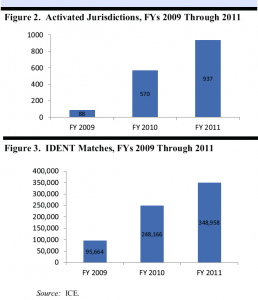DHS Inspector General Fluffs the Success of Secure Communities
Last Friday, DHS’ Inspector General released two reports purportedly written in response to an April 28, 2011 request from Zoe Lofgren to determine whether Immigration and Customs Enforcement and DHS more generally were lying about the Secure Communities program, and if so, if doing so was criminal.
As a threshold matter, the completion of two reports, rather than just the one, seems to be a bit of a smokescreen. Lofgren asked if government officials lied. In response, DHS’ IG decided to answer two questions:
- Whether Secure Communities was effective in identifying criminal aliens and prioritizing cases for action
- Whether ICE clearly communicated to stakeholders the intent of Secure Communities and the expectation of States’ and local jurisdictions’ participation
In addition to reframing Lofgren’s question to avoid fully considering why people had misinformed Congress and localities (and also, given the scope of their work, to avoid inquiring whether DHS, rather than ICE, had decided to do so), DHS IG first decided to see whether Secure Communities was effective. According to the list of major contributors included with each report, with the sole exception of Communications Analyst Kelly Herberger, two entirely different teams conducted the reviews. The report that at least sort of responded to Lofgren’s questions was issued on March 27, whereas the non-responsive efficacy report was issued April 5, though both were apparently sent out Friday together. ICE responded to both reports on the same day–February 23, 2012–so it seems the different release dates comes because the efficacy report was revised in some way (the date on the conveyance letter for the efficacy report is in a non-standard sans serif font, which sort of makes you wonder…).
In short, the submission of these two reports together stinks, though it presumably had the desired effect, as the NYT reported “mixed reviews” for Secure Communities. HuffPo and LAT were less compliant, focusing instead on the communications report instead.
That said, the purported “good” efficacy report doesn’t actually prove that Secure Communities is working all that well. Here’s the summary of their results:
We performed this audit to determine if Secure Communities was effective in identifying criminal aliens and if Immigration and Customs Enforcement appropriately prioritized cases for removal action.
Secure Communities was effective in identifying criminal aliens, and in most cases, ICE officers took enforcement actions according to agency enforcement policy. Under Secure Communities, the agency expanded its ability to identify criminal aliens in areas not covered by its other programs. In addition, it was able to identify criminal aliens earlier in the justice process, some of whom it would not have identified under other programs. Secure Communities was implemented at little or no additional cost to local law enforcement jurisdictions. Although ICE was able to identify and detain criminal aliens, field offices duplicated the research associated with their detention, and officers did not always sufficiently document their enforcement actions. To improve the transparency and thoroughness of its processes under Secure Communities, the agency needs to eliminate the duplication of research and ensure that officers fully document their actions.
One of the ways they quantify that success is with a claim that they had identified 692,000 “criminal aliens.”
According to ICE, as of September 30, 2011, it had spent most of the $750 million and identified more than 692,000 criminal aliens.
 Now, the graphics they provide to back up this claim do show 692,788 “IDENT” matches in the last 3 fiscal years.
Now, the graphics they provide to back up this claim do show 692,788 “IDENT” matches in the last 3 fiscal years.
Never mind that the program has become less efficient over the years. In FY2009, ICE had 1,087 fingerprint matches for each activated jurisdiction, in FY2011 ICE had 372 matches. To some degree that’s expected–jurisdictions along the southern border joined in first–but also suggests getting every jurisdiction in the country involved has diminishing returns.
More troubling, the report also reveals that some of the people–it doesn’t say how many–in IDENT are citizens.
Individuals with fingerprints in IDENT include persons with an immigration history, such as aliens who have been removed but have reentered the country, immigration visa applicants, legal permanent residents, naturalized citizens, and some U.S. citizens.
IDENT includes two categories of U.S. citizens:
- Citizens who have adopted a child from abroad (which involves U.S. Citizenship and Immigration Services), participated in a trusted traveler program, or may have been fingerprinted by immigration officials for smuggling aliens or drugs across U.S. borders;
- Individuals who were not citizens at the time that their fingerprints were collected, but subsequently became citizens through naturalization, legal permanent residency, or immigration.
So if you’ve adopted a kid from China? You’re in this database too. Read more →
